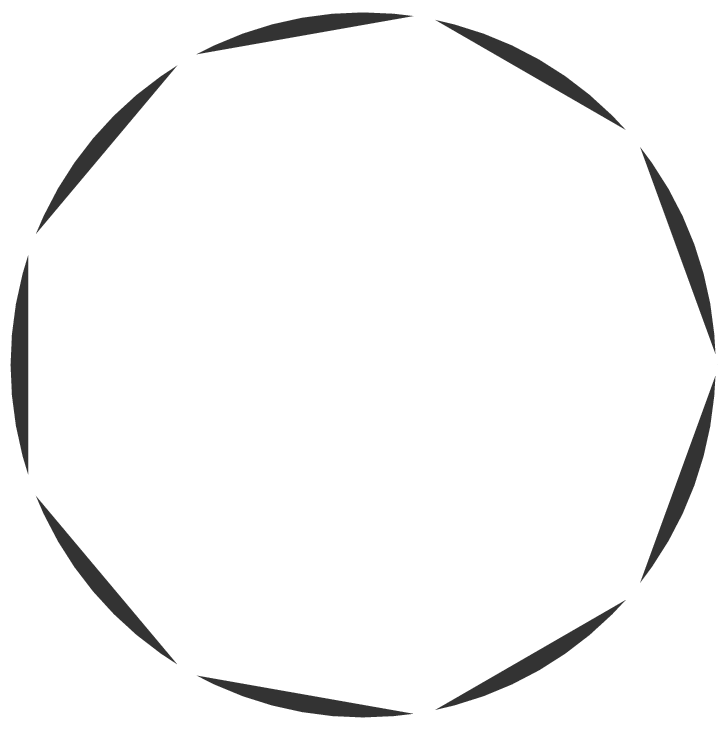
Ich möchte eine Objektivblende mit unterschiedlichen Blendenzahlen (Lochgrößen) erstellen. Ich habe mit diesem Code angefangen, aber er lässt es nicht wie eine vollständige Blende aussehen. Ich bin für jede Hilfe dankbar.
\documentclass[aspectratio=43]{beamer}
\usepackage{tikz}
\begin{document}
\begin{frame}{Aperture image}
\begin{tikzpicture}
\clip (0,0) circle(1);
\draw[thick] (0,0) circle(1);
\foreach \r in {0,40,...,360}
\filldraw[fill = black!80,draw = white,thick, rotate = \r] (-3,-1) rectangle (-0.5,1);
\end{tikzpicture}
\end{frame}
\end{document}
Antwort1
Antwort2
Etwas spät, aber das Folgende definiert ein picmehr oder weniger konfigurierbares Skript (und ich habe es sofort verwendet, um eine Animation zu erstellen). Die Berechnungen sind höchstwahrscheinlich ineffizient und der Gesamtcode sieht nicht so gut aus wie die, die von den üblichen Ti gepostet werdenkZ-Experten.
\documentclass[tikz]{standalone}
\tikzset
{
,aperture segments/.initial = 6
,aperture radius/.initial = 3
,aperture closed/.initial = .5
,aperture/.pic={
\begin{scope}
\pgfkeysgetvalue{/tikz/aperture segments}\segments
\pgfkeysgetvalue{/tikz/aperture radius}\rad
\pgfkeysgetvalue{/tikz/aperture closed}\closed
\pgfmathsetmacro\ang{360/\segments}
\pgfmathsetmacro\endang{360-\ang}
\pgfmathsetmacro\alphtild{(180-\ang)/2}
\pgfmathsetmacro\rp{(1-\closed)*\rad}
\pgfmathsetmacro\cc{\rad*sqrt(2*(1-cos(\ang)))}
\pgfmathsetmacro\bp{sqrt(\rad*\rad+\rp*\rp-2*\rad*\rp*cos(\ang))}
\pgfmathsetmacro\alphprim{asin(\rp/\bp*sin(\ang))}
\pgfmathsetmacro\alph{\alphtild-\alphprim}
\pgfmathsetmacro\bet{180-\ang-\alph}
\pgfmathsetmacro\bb{\cc*sin(\bet)/sin(\ang)}
\foreach \r in {0,\ang,...,\endang}
{
\filldraw[fill = black!80, draw = white, thick, rotate = \r]
(0:\rad) ++(180-\alphprim:\bb) -- (0:\rad)
arc[start angle=0, end angle=\ang, radius=\rad]
-- cycle;
}%
\end{scope}%
}
}
\begin{document}
\foreach\x in {0,0.025,...,1}
{
\begin{tikzpicture}
\pic [aperture segments=9, aperture closed=\x] {aperture};
\end{tikzpicture}
}
\foreach\x in {1,0.975,...,0}
{
\begin{tikzpicture}
\pic [aperture segments=9, aperture closed=\x] {aperture};
\end{tikzpicture}
}
\end{document}
Ein kleines Dokument, das beschreibt, was oben berechnet wird und warum:
\documentclass[]{article}
\title{Aperture drawing}
\author{Skillmon}
\date{}
\usepackage{tikz}
\usepackage[]{amsmath}
\usepackage{array}
\usepackage{collcell}
\usepackage{booktabs}
\usepackage{siunitx}
\newcolumntype\mathcol[1]{>{\startmath}#1<{\endmath}}
\let\startmath\(
\let\endmath\)
\newcolumntype\macrocol[1]{>{\collectcell\makemacroname}#1<{\endcollectcell}}
\newcommand\makemacroname[1]
{%
\texttt{\expandafter\string\csname #1\endcsname}%
}
\begin{document}
\maketitle
The geometry we use is shown in figure~\ref{fig:geom}.
In the equations below variables correspond to the names in the used
Ti\textit{k}Z code to draw the aperture. The correspondences are shown in
table~\ref{tab:corres}. In the following I don't care about the sign of the
angles denoted with $\angle P_1P_2P_3$ and always only care for their absolute
value, so $\angle P_1P_2P_3$ might actually be $\angle P_3P_2P_1$.
\begin{figure}
\centering
\begin{tikzpicture}
\def\segments{9}
\def\rad{3}
\def\closed{0.3}
\pgfmathsetmacro\ang{360/\segments}
\pgfmathsetmacro\endang{360-\ang}
\pgfmathsetmacro\alphtild{(180-\ang)/2}
\pgfmathsetmacro\rp{(1-\closed)*\rad}
\pgfmathsetmacro\cc{\rad*sqrt(2*(1-cos(\ang)))}
\pgfmathsetmacro\bp{sqrt(\rad*\rad+\rp*\rp-2*\rad*\rp*cos(\ang))}
\pgfmathsetmacro\alphprim{asin(\rp/\bp*sin(\ang))}
\pgfmathsetmacro\alph{\alphtild-\alphprim}
\pgfmathsetmacro\bet{180-\ang-\alph}
\pgfmathsetmacro\bb{\cc*sin(\bet)/sin(\ang)}
\draw
(0,0) coordinate(O) circle [radius=1.5pt] node [below]{$O$}
(0:\rad) coordinate(A) circle [radius=1.5pt] node [below right]{$A$}
++(180-\alphprim:\bb)
coordinate(C) circle [radius=1.5pt] node [above left]{$C$}
(\ang:\rad) coordinate(B) circle [radius=1.5pt] node [above right]{$B$}
(\ang:\rp) coordinate(D) circle [radius=1.5pt] node [below]{$D$}
;
\draw[blue]
(A) arc[start angle=0, end angle=40, radius=3cm] -- (C) -- cycle;
\draw[gray, dashed]
(O) -- (A)
(A) -- (B)
(O) -- (B)
;
\end{tikzpicture}
\caption
{%
The geometry in which we want to calculate the position of point $C$%
\label{fig:geom}%
}
\end{figure}
\begin{table}
\centering
\begin{tabular}{\mathcol{c} \macrocol{l} \mathcol{l}}
\toprule
\multicolumn{1}{l}{Variable} & \multicolumn{1}{l}{Macro name}
& \multicolumn{1}{l}{Meaning} \\
\midrule
\bar{p} & closed & \overline{DB}/\overline{OB} \\
n & segments \\
r & rad & \overline{OA}=\overline{OB} \\
\gamma & ang & \angle AOB \\
\tilde{\alpha} & alphtild & \angle OAB \\
r_p & rp & \overline{OD} \\
c & cc & \overline{BA} \\
b_p & bp & \overline{AD} \\
\alpha' & alphprim & \angle OAC \\
\alpha & alph & \angle CAB \\
\beta & bet & \angle ABC \\
b & bb & \overline{AC} \\
\bottomrule
\end{tabular}
\caption
{%
Variable-Macro-Correspondence and their geometrical meaning in
figure~\ref{fig:geom}.%
\label{tab:corres}%
}
\end{table}
The variables we know the values of are $n$, $r$, and $\bar{p}$. $\bar{p}$ is in
the range $[0,1]$ and describes how closed the aperture is. $n$ is the number of
aperture segments and $r$ is the outer radius of the aperture. From $n$ we get
the angle $\gamma = \angle AOB$ straight forward:
\begin{equation}
\gamma = \frac{\ang{360}}{n}
\end{equation}
Also relatively easy to calculate are the value of $p$ and $r_p$:
\begin{align}
p &= 1 - \bar{p} \\
r_p &= rp
\end{align}
The next thing we want to know is the angle $\angle ACB$. We know how many edges
the polygon of the aperture will have ($n$), so we know the sum
of internal angles and $\angle ACB$ is the adjacent angle of one of the internal
angles:
\begin{equation}
\angle ACB = \ang{180} - \ang{180} \frac{(n - 2)}{n}
= \ang{180} \cdot (1 - 1 + \frac{2}{n}) = \frac{\ang{360}}{n} = \gamma
\end{equation}
The distances $c$ and $b_p$ can be calculated using the law of cosines:
\begin{align}
c &= \sqrt{2r^2 - 2r^2\cos \gamma} = r \sqrt{2(1-\cos\gamma)} \\
b_p &= \sqrt{r^2 + r_p^2 - 2rr_p\cos\gamma} \label{eq:bp}
\end{align}
We could further simplify eq.~\ref{eq:bp}, but this should suffice.
$\tilde{\alpha}$ can be calculated with the sum of internal angles in the
triangle $OAB$ since it is isosceles. With the sine theorem we can calculate
$\alpha'$ and therefore $\alpha$ and $\beta$:
\begin{align}
\tilde{\alpha} &= \frac{\ang{180}-\gamma}{2} \\
\alpha' &= \arcsin ( \frac{r_p}{b_p}\sin\gamma ) \\
\alpha &= \tilde{\alpha} - \alpha' \\
\beta &= \ang{180} - \gamma - \alpha
\end{align}
Using the sine theorem again we calculate the value of $b$ and with the position
of $A$ and the angle $\alpha'$ we get the position of $C$:
\begin{equation}
b = c \frac{\sin\beta}{\sin\gamma}
\end{equation}
In Ti\textit{k}Z the point $C$ is now positioned at
\verb|(0:\rad) ++(180-\alphprim:\bb)|. Now we can draw our aperture segments.
\end{document}





